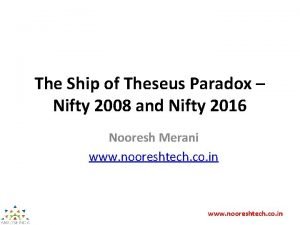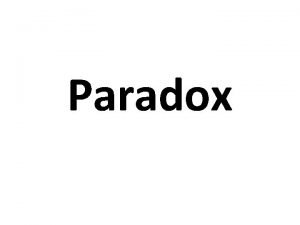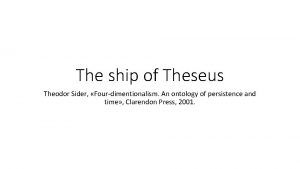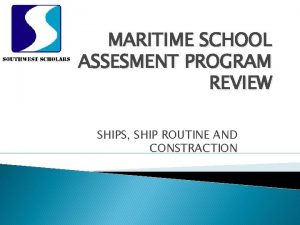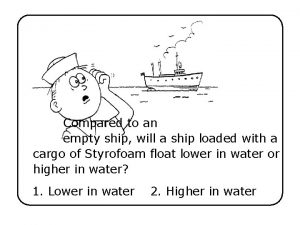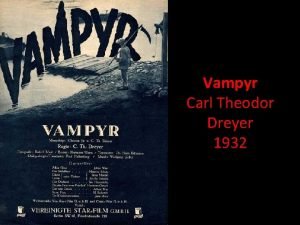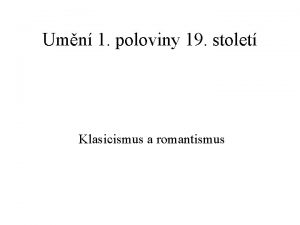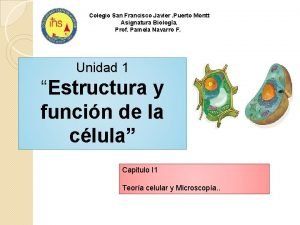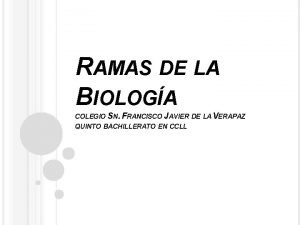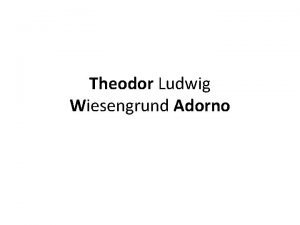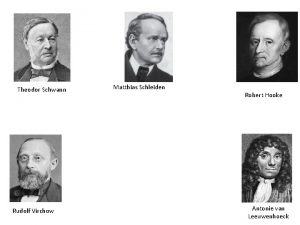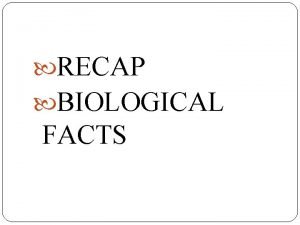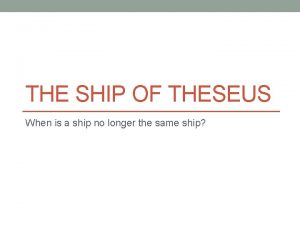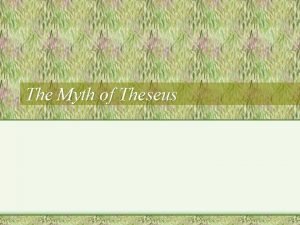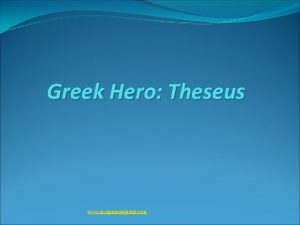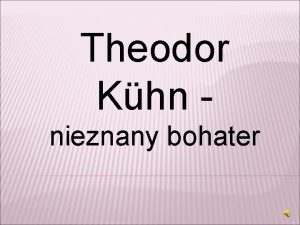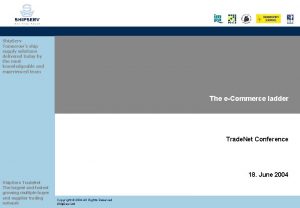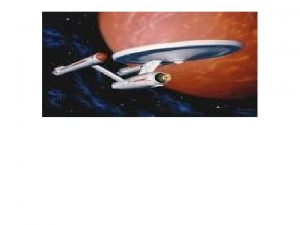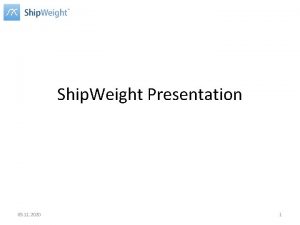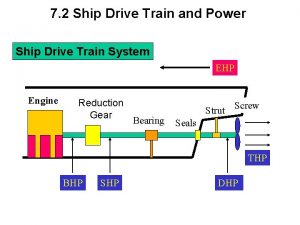The ship of Theseus Theodor Sider Fourdimentionalism An


















- Slides: 18

The ship of Theseus Theodor Sider, «Four-dimentionalism. An ontology of persistence and time» , Clarendon Press, 2001.

The ship of Theseus It’s a philosophical puzzle known since ancient times. It refers to the story told by Plutarch in the Life of Theseus. The problem concerns persistence through time and we can already find it in Plato’s Fedone (58 A) and in Senofane’s Memorabilia (4, 8, 2). Also Leibniz speaks about it in his “New essays concerning human understanding” (II, 27, 4). Hobbes deals with this problem in his De corpore, also introducing a new scenario about this problem.

The problem in short The planks of the original ship of Theseus have been removed from time to time and stored in a worehouse in order to assemble a new ship. Which is the original ship? The "renovated ship”(called ‘Replacement’ by Sider), that is the ship to which the pieces have been replaced from time to time, or the “reconstructed ship”(christened ‘Planks’ by Sider), that is the ship that was built with the pieces of the original one?

What is four-dimentionalism? • Sider defines “four-dimensionalism” as “an ontology of the material world according to which objects have temporal as well as spatial parts”[XIII]. • More precisely, he adds: “necessarily, each spatio-temporal object has a temporal part at every moment at which it exists”[59]. To sum up: • Four-dimentionalism is the doctrine according to which time must be understood as a dimension, just like three dimensions of space, and the objects extended in time are divisible in temporal parts. As a consequence, identity is a matter of persistence over time.

A particular version of four-dimentionalism: THE STAGE VIEW The standard four-dimensionalist view is the so-called “worm view”, according to which everyday things are temporally extended and the persisting objects are the sum or set(the so-called “worm”) of all their temporal parts. Sider argues for an another version of fourdimensionalism (without denying the worm view at all), the “stage view”, according to which everyday things have temporal parts that succeed one another through time. An object is an instantaneous stage and the other stages of this persisting object are related to that stage through a "temporal counterpart relation".

The temporal counterpart theory The is a possible objection to the stage view: it denies persistence over time because «stages don't continue» [193]. The solution is represented by the temporal counterpart relation, also known as the ‘genidentity relation’, the ‘unity relation’, the ‘I-relation’.

Let’s explain it with an example: ‘Ted was once a boy’ = «there exists some person stage x prior to the time of utterance, such that x is a boy, and x bears the temporal counterpart relation to Ted» [193]. “Ted was a boy” means that «he has the historical property of once being a boy» [193]. Note: There is a close analogy here with modal counterpart theory of David Lewis.

Sider defends a tenseless B-theory of time Sider writes: - «The philosophy of time defended is the B-theory, the so-called ‘tenseless theory of time’. Rival ‘tensed’ theories of time, in particular presentism, are rejected» [XIII] - «In this book I will presuppose the B-theory—eternalism plus the reducibility of tense» . [25]

B-theory of time: combination of eternalism and reductionism about tense • the past and future as real as the present «an object has temporal parts located in the past and future» [71]. • Tensed facts are reducible to eternal, tenseless facts «an object has (timelessly) past and future temporal parts» [71]. Example: “I once was a boy”= I have a past temporal counterpart which is tenselessly a boy.

The b-theory and change «Change can be described using tenseless attributions of properties to things at times» [168]. Indeed, «Tenseless property attributions constitute change» [168].

The principle of unrestricted mereological composition «For any objects, there exists such a thing as the mereological sum, or fusion of those objects—a larger object that contains those objects as parts. According to this principle, any group of objects has a sum, even a group of objects that is very scattered. There exists, for example, a thing that is made up of the coins in my pocket, the Eiffel Tower, and all the polar bears in the world» [7].

Towards a solution of the paradox of the ship of Theseus «Given the principle of unrestricted composition, the four-dimensional world of stages also contains a mereological sum for each collection of stages. We have already met some of these sums: the spacetime worms with which the fourdimensionalist identifies everyday objects. But once unrestricted composition is accepted, any set of stages has a sum[…]. The world is therefore populated by a host of continuing spacetime worms, of which we name, think of, and quantify over a small minority» [8].

Is the Ship of Theseus identical to “Replacement” (the renovated ship) or “Planks” (the reconstructed ship)? Answer: «There exist spacetime worms corresponding to each answer. […] Which is The Ship of Theseus, Replacement or Planks? The answer depends on our concept of a ship» [8].

1. The «replacement worm» : emphasis on persistence in ship form The “replacement worm” is the spacetime worm made up of the following stages: -the original Ship of Theseus's stages before replacement occurs -Ship 1's stage after one plank has been replaced -Ship 2's stage after the second plank has been replaced ·· -Ship n's stage after n planks have been replaced -Replacement's stages after the final plank has been put into place.

2. «The original planks worm» : emphasis on the sameness of planks ‘The original planks worm’ consists of the stages of all and only the original planks of The Ship of Theseus. This worm is co-located with The Ship of Theseus at the beginning of the process, and is co-located with Planks (the reconstructed ship) at the end of the process.

Conclusion (1): Our concept of ship can also refer to other worms «There are many other spacetime worms that begin coinciding with our Ship of Theseus and trace out different paths through spacetime to either Planks or Replacement, for example a worm like the original planks worm but missing the stages when the planks are not all assembled in ship form. This worm goes out of existence after the removal of some of the planks and resumes existence when the discarded planks are assembled to make Planks. Perhaps our concept of a ship applies to one of these other worms. Whether the Ship of Theseus is identical to Replacement or Planks would depend on which of these worms counts as a ship and is thus designated by ‘The Ship of Theseus’» [9].

Conclusion (2): there is no determinate answer because of the indeterminacy of our concept of ship «Another interesting possibility is that there may be no determinate answer to the question of which spacetime worms count as ships. Indeterminacy in our concept of a ship would result in a kind of indeterminacy or ambiguity in the expression ‘The Ship of Theseus’ over several candidate spacetime worms. There might then be no answer to our question of whether The Ship of Theseus is identical to Replacement or Planks» [9].

At the end, we can conclude that, if we accept four-dimensionalism (first of all the idea that exist temporal parts) and all the metaphysical principles underlying it (such as the b-theory of time, the temporal counterpart relation, the unrestricted mereological composition and so on), there is no paradox about the ship of Theseus. However, there are many reasons (for example, look at those brought by Chisholm in his "Problems of Identity") to deny their validity. Thank you for the attention.
 Sider
Sider Theseus' paradox
Theseus' paradox Logical paradox examples
Logical paradox examples Worm theory ship of theseus
Worm theory ship of theseus Ship ship routines and construction
Ship ship routines and construction Difference between empty ship and loaded ship
Difference between empty ship and loaded ship Theodor heuss werkrealschule böblingen
Theodor heuss werkrealschule böblingen Vampyr (1932)
Vampyr (1932) Dantova bárka
Dantova bárka Theodor heuss schule preetz
Theodor heuss schule preetz Colegio san francisco javier
Colegio san francisco javier Theodor schwam
Theodor schwam Theodor ludwig wiesengrund adorno
Theodor ludwig wiesengrund adorno Theodor homburger
Theodor homburger Mathias virchow
Mathias virchow Theodor schwann facts
Theodor schwann facts Soria moria theodor kittelsen analyse
Soria moria theodor kittelsen analyse Pirpiliu ionel
Pirpiliu ionel Theodor fontane wichtigste werke
Theodor fontane wichtigste werke

